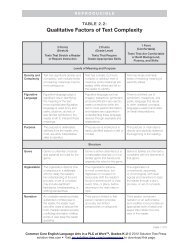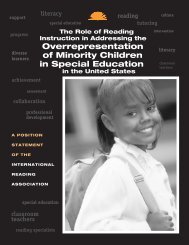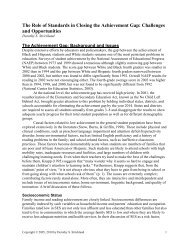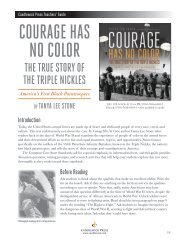What Research Has to Say About Reading Instruction - International ...
What Research Has to Say About Reading Instruction - International ...
What Research Has to Say About Reading Instruction - International ...
Create successful ePaper yourself
Turn your PDF publications into a flip-book with our unique Google optimized e-Paper software.
Gather Resources<br />
Familiarize yourself thoroughly with the book you’ll be reading in<br />
your study group. <strong>What</strong> <strong>Research</strong> <strong>Has</strong> <strong>to</strong> <strong>Say</strong> <strong>About</strong> <strong>Reading</strong> <strong>Instruction</strong><br />
is a key text in the field, in which highly respected scholars highlight<br />
the best thinking on important literacy <strong>to</strong>pics. Edi<strong>to</strong>r Alan Farstrup<br />
has served as both research direc<strong>to</strong>r and executive direc<strong>to</strong>r of the<br />
<strong>International</strong> <strong>Reading</strong> Association; Jay Samuels has been on the<br />
faculty of the University of Minnesota since 1965 and is one of the<br />
field’s recognized leaders on the <strong>to</strong>pic of fluency. Contribu<strong>to</strong>rs <strong>to</strong> this<br />
volume include P. David Pearson, dean of the College of Education at<br />
the University of California, Berkeley; Timothy Shanahan, a member<br />
of the U.S. National <strong>Reading</strong> Panel and professor at the University of<br />
Illinois, Chicago; and distinguished educa<strong>to</strong>r and researcher Dorothy<br />
Strickland of Rutgers University. You should become comfortable<br />
yourself with the entire book, but also identify those chapters that<br />
you might wish <strong>to</strong> skip in your study group because their <strong>to</strong>pics aren’t<br />
relevant <strong>to</strong> the group’s needs and interests as a whole.<br />
In addition, you should familiarize yourself with this guide and<br />
with the additional resources included in the Appendix.<br />
Before your first meeting, make sure that every participant in your<br />
study group has a copy of the book.<br />
Finally, make copies of your school’s continuous improvement<br />
plan, state or district standards, other documents or research that may<br />
be relevant <strong>to</strong> your study, and any forms required by your school or<br />
district for tracking group members’ participation.<br />
Using This Resource<br />
The next section of this guide takes you through a suggested sequence<br />
for your study group. School environments vary, so these guidelines<br />
are intended <strong>to</strong> provide a flexible model. Using this model, you<br />
can tailor group sessions so they are relevant <strong>to</strong> the needs of your<br />
particular school and promote optimal professional development for<br />
your faculty and staff. Most session plans focus on a single chapter of<br />
the book and are self-contained, so if the <strong>to</strong>pic of a chapter doesn’t fit<br />
your school’s priorities or context, you can skip over that session.<br />
After welcoming participants, you should open each session with<br />
a brief recap of the previous meeting and, in a group discussion,<br />
share learning and questions from follow-up activities undertaken<br />
From the Professional Development Edition of <strong>What</strong> <strong>Research</strong> <strong>Has</strong> <strong>to</strong> <strong>Say</strong> <strong>About</strong> <strong>Reading</strong> <strong>Instruction</strong><br />
(3rd ed.), © 2009 <strong>International</strong> <strong>Reading</strong> Association.<br />
4
















